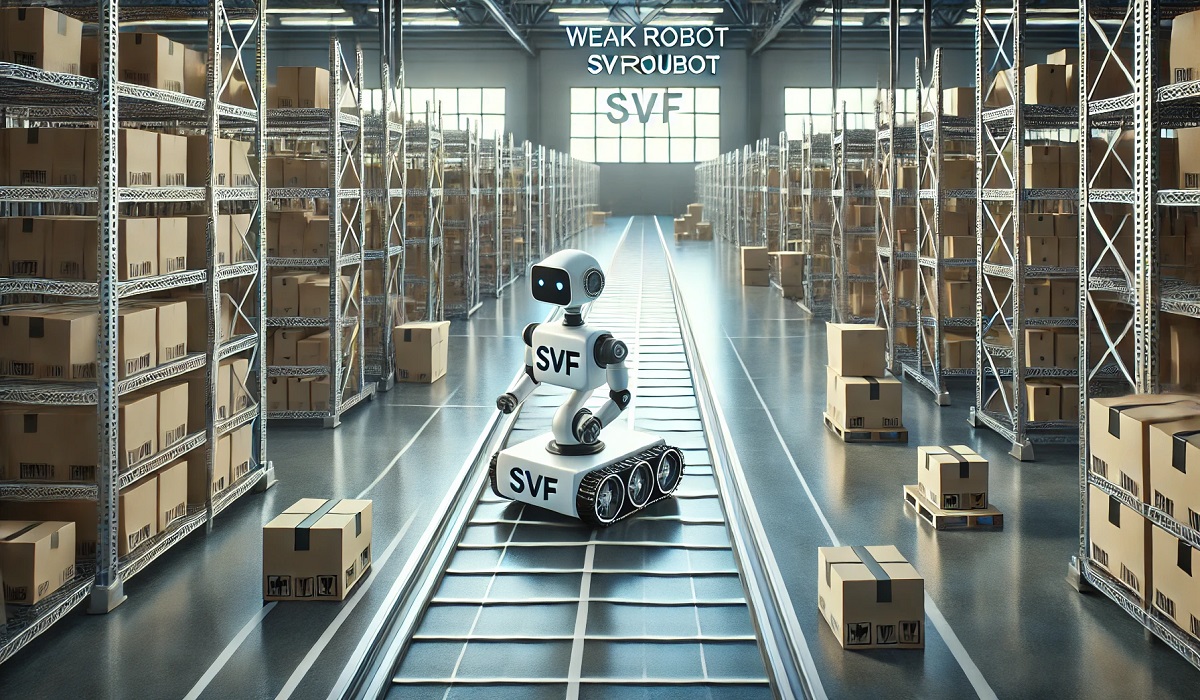TECHNOLOGY
Weak Robot SVF: Applications, Challenges, and Future

Robotics is rapidly advancing, yet the concept of “weak robot SVF” stands out as a critical topic. Weak robot SVF systems, though less complex than their advanced AI counterparts, play an essential role in industries reliant on task-specific automation. This article dives deep into weak robot SVF, its applications, limitations, and its potential to transform specific sectors.
What Does Weak Robot SVF Mean?
The term “weak robot SVF” describes robotics systems designed to perform limited, task-specific functions, often relying on a Software Virtualization Framework (SVF) to execute their tasks. Unlike strong AI robots, weak robots are not capable of reasoning or learning beyond predefined programming.
Weak robot SVF systems are particularly valuable in environments where repetitive or narrowly defined actions are required, such as factories, warehouses, and logistics centers. They are less expensive, easier to maintain, and simpler to deploy, making them accessible to a broader range of industries.
Key Features of Weak Robot SVF
Weak robot SVF systems are built on certain core principles:
- Task-Specific Design: Limited to narrow, repetitive actions.
- Simplified Programming: Relies on basic algorithms instead of advanced AI.
- Energy Efficiency: Consumes minimal computational resources.
- Reliability: Performs consistently within its constraints.
- Cost-Effectiveness: Affordable compared to advanced robotics systems.
Applications of Weak Robot SVF in Industries
Manufacturing and Assembly Lines
Weak robot SVF systems are commonly used in industrial settings to perform repetitive tasks such as assembly, welding, and packaging. Their reliability and efficiency reduce production costs significantly.
Warehouse and Logistics Automation
Robots equipped with SVF technology handle sorting, transporting, and inventory management in warehouses. For instance, automated guided vehicles (AGVs) rely on predefined pathways to move goods within logistics hubs.
Healthcare Support
Weak robot SVF systems are utilized in healthcare for tasks like medication delivery, equipment sterilization, and patient assistance. They reduce the workload of human healthcare providers while enhancing operational efficiency.
Retail and Customer Assistance
In retail, weak robots assist with inventory tracking and customer service. They perform tasks like restocking shelves or guiding customers to specific sections.
Agriculture and Farming
Robots using weak SVF are increasingly popular in agriculture. They are employed for tasks like planting seeds, spraying pesticides, or monitoring crops, ensuring precision and reduced labor costs.
Advantages of Weak Robot SVF
- Affordable Deployment: Lower cost of entry compared to AI-driven robots.
- Predictable Performance: Fewer errors due to a narrow scope of functionality.
- Scalability: Can be scaled up or down for specific operational needs.
- Safety: Designed for minimal risk in human-robot collaborative environments.
- Reduced Maintenance Costs: Less wear and tear due to simpler mechanisms.
Challenges and Limitations
Weak robot SVF systems, despite their utility, have significant limitations:
- Inflexibility: They cannot adapt to changing environments or tasks.
- Dependence on Human Oversight: Often requires manual intervention for task modifications.
- Vulnerability to Software Errors: Bugs in the SVF can disrupt operations.
- Inability to Process Complex Data: Weak robots are limited to predefined inputs and outputs.
- Restricted Applicability: Unsuitable for scenarios that demand advanced decision-making or reasoning.
How Weak Robot SVF Differs from Strong AI Robots
| Feature | Weak Robot SVF | Strong AI Robots |
|---|---|---|
| Scope of Intelligence | Narrow, task-specific functionality | Generalized and adaptive intelligence |
| Autonomy | Limited | High |
| Programming | Rule-based | Machine learning or neural networks |
| Cost | Lower | Higher |
| Applications | Repetitive, well-defined tasks | Complex, multi-variable tasks |
Weak robots excel in cost-efficiency and simplicity but are not designed for adaptive or unpredictable environments.
Future Trends in Weak Robot SVF
The future of weak robot SVF is promising, with trends indicating greater integration into everyday processes:
- Improved Software Virtualization: Enhancements in SVF will lead to more efficient robots capable of handling a wider range of tasks.
- IoT Integration: The Internet of Things (IoT) will enable real-time communication between robots and other devices.
- Wider Adoption by Small Businesses: The affordability of weak robots makes them an ideal choice for smaller enterprises.
- Hybrid Systems: Combining weak robot SVF systems with AI-driven robots will balance cost and functionality.
How to Optimize Weak Robot SVF for Industrial Use
To maximize the efficiency of weak robots, businesses should focus on:
- Software Maintenance: Regular updates to SVF systems to avoid bugs.
- Environment Optimization: Ensuring the robot’s operating environment is predictable and structured.
- Training: Providing task-specific programming tailored to the robot’s purpose.
- Routine Maintenance: Conducting periodic checks to ensure hardware reliability.
Examples of Weak Robot SVF in Action
- Automated Cleaning Robots
Robotic vacuum cleaners use basic algorithms to map and clean areas efficiently. - Warehouse Sorting Systems
Robots equipped with SVF streamline order processing in large e-commerce warehouses. - Robotic Arms in Manufacturing
These robots perform repetitive tasks like assembling car parts with high precision. - Farming Equipment
Seed-planting robots enhance agricultural productivity while reducing manual labor.
Steps to Implement Weak Robot SVF in Your Business
- Identify Requirements: Clearly define the tasks to be automated.
- Choose the Right Robot: Select a system that aligns with operational needs.
- Integrate SVF Software: Install and configure the necessary software.
- Test the System: Conduct trials to ensure efficiency and reliability.
- Monitor and Maintain: Regularly check performance and update the framework as needed.
Conclusion
Weak robot SVF systems are revolutionizing industries that demand precision, affordability, and reliability. While these robots lack the complexity and adaptability of strong AI systems, their simplicity and efficiency make them indispensable in specific applications. As advancements in SVF technology continue, weak robots will likely become even more versatile, shaping the future of task-specific automation.
FAQs
How is weak robot SVF different from traditional automation?
Weak robot SVF is more flexible due to its reliance on software virtualization, allowing it to handle varied tasks within predefined limits.
What industries benefit most from weak robot SVF?
Industries like manufacturing, logistics, healthcare, retail, and agriculture benefit significantly from these robots.
Can weak robots replace human workers entirely?
No, weak robots complement human workers by automating repetitive tasks but lack the adaptability needed for complex roles.
What are the costs associated with weak robot SVF systems?
Initial costs are lower compared to strong AI robots, making them a cost-effective choice for task-specific operations.
How does SVF enhance weak robots?
SVF enables dynamic task allocation and simplifies software updates, improving efficiency and adaptability within defined constraints.
What is the lifespan of a weak robot SVF system?
With proper maintenance and software updates, weak robots can last several years, depending on the operational environment.

 BUSINESS8 months ago
BUSINESS8 months agoService Top: Understanding Role, Dynamics, and Consent in Relationships

 TECHNOLOGY7 months ago
TECHNOLOGY7 months agoSSIS 858: Everything You Need to Know

 GUIDE6 months ago
GUIDE6 months agoLookmovie2.to Legit: A Detailed Review of Safety and Features

 FASHION7 months ago
FASHION7 months agoDIY Tips to Customize Your Orange Prom Dress and Stand Out

 GUIDE6 months ago
GUIDE6 months agoTokybook: Your Gateway to the World of Audiobooks

 TECHNOLOGY7 months ago
TECHNOLOGY7 months agoUnderstanding Libgen: The Ultimate Free Ebook Library

 GUIDE8 months ago
GUIDE8 months agoLeague of Graphs: The Ultimate Guide to League of Legends Stats and Analysis

 GUIDE7 months ago
GUIDE7 months agoLook at All Those Chickens: The Story Behind the Viral Meme
















